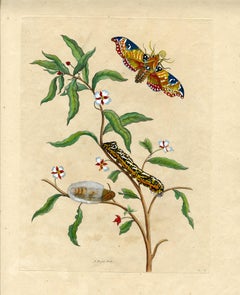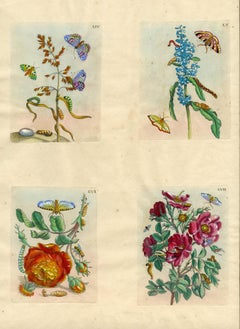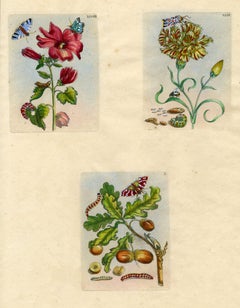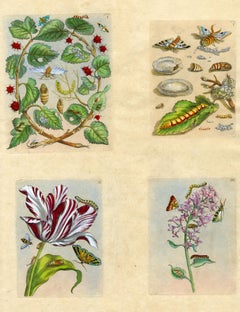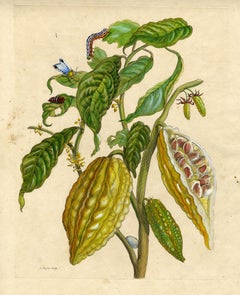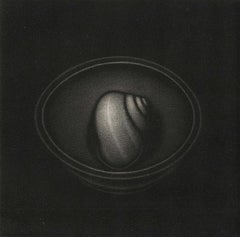Maria Sybilla Merian Animal Prints
Dutch, 1647-1717
Maria Sibylla Merian (1647—1717) was a naturalist and artist. Her contributions to entomology were never appropriately recognized in her lifetime. She is now considered to be a pioneer in the fields of botany and zoology. She made detailed observations of live specimens, which was a departure from previous studies that used preserved specimens. She focused great detail on the processes of metamorphosis, which had not been studied so comprehensively before her work. The engravings for the publication were done by J. Mulder, P. Sluyter and A. Stopendaal, all after paintings on vellum by Merian. The work is considered to be one of the most beautiful, and famous illustrated natural history works of the 18th century. The work was the result of Merian's trip in 1699 with her daughter Dorothea to Surinam, a Dutch colony on the northeastern coast of South America. The pair studied and recorded plants and insects for two years under difficult conditions. They came back to Amsterdam with specimens, notes and drawings and there completed their astounding work. One naturalist proclaimed "Her portrayals of living insects and other animals were imbued with a charm, a minuteness of observation and an artistic sensibility that had not previously been seen in a natural history book; if Gould and Audubon have 'a spiritual ancestor, then it is difficult to think of a more worthy claimant to the title than Maria Sibylla Merian." On the day Maria Sibylla Merian died, Tsar Peter the Great purchased a two-volume collection of her unbound paintings, as well as her journal.
Born in Frankfurt am Main, Maria Sibylla Merian was the daughter of Matthaus Merian the Elder (1593—1650), a famous German-Swiss painter, engraver and publisher. Her father died when she was three and her mother remarried Jacob Marrel (1614-1681), who was a still-life painter. From the time she was eleven, Marrel schooled Maria Sibylla Merian in the tradition of northern European still life painting, working directly from life. As her interests evolved toward the study of insects, she employed these artistic skills to create her outstanding scientific and esthetically beautiful works. She was truly at the crossroads of art and science.(Biography provided by Timeless Intaglio)
to
11
11
4
6
1
Overall Height
to
Overall Width
to
9
7
6
5
5
5
3
2
2
1
1
1
1
1
1
11
10
62
289
247
210
125
10
10
10
Artist: Maria Sybilla Merian
Tree with moth, caterpillar..., Plate 39, Metamorphosis Insectorum Surinamensium
By Maria Sibylla Merian
Located in Middletown, NY
Metamorphosis Insectorum Surinamensium, Plate No. 39; Unidentified tree with moth, caterpillar and pupa.
The Netherlands: 1705....
Category
Early 18th Century Naturalistic Maria Sybilla Merian Animal Prints
Materials
Watercolor, Engraving
Thistle and Moths, plate no. 6, Metamorphosis Insectorum Surinamensium
By Maria Sibylla Merian
Located in Middletown, NY
Metamorphosis Insectorum Surinamensium, Plate No. 6; Thistle and Moths. The Netherlands: 1705. Engraving with hand coloring in w...
Category
Early 18th Century Naturalistic Maria Sybilla Merian Animal Prints
Materials
Watercolor, Engraving
4 plates from The Wondrous Transformation of Caterpillars & their Strange Diet..
By Maria Sibylla Merian
Located in Middletown, NY
Four plates from The Wondrous Transformation of Caterpillars and their Strange Diet of Flowers. “Wolfsmelk Rupsen;" “Wolfsmilch, Raupe und Schmetterling" Amsterdam: J F Bernard, 1730. Each an engraving with hand coloring in watercolor and gouache printed on one sheet of watermarked Honig cream laid paper, each measures 6 1/4 x 5 inches (157 x 121 mm), sheet measures 20 5/8 x 14 inches (522 x 355 mm), full margins. With handling creases in the lower right sheet quadrant, as well as minor, loose cockling, otherwise in very good condition. The colors are superb with exceptionally fresh and bright saturation. Engraved between 1679 and 1683, printed 1730. Plates included: LIV, LV, LVI, & LVII.
MARIA SIBYLLA MERIAN was one of the most highly respected entomologists of the 17th century, and remains today one of the field's most significant figures. A German-born naturalist and scientific illustrator, she reared herself on the study of caterpillars, and made tremendous contributions to the knowledge of the life cycles of numerous species. Until her detailed and careful study of the process of metamorphosis it was thought that insects were "born of mud," through spontaneous generation.
Trained as a miniature painter by her stepfather, she published her first book of illustrations in 1675, at the age of 28. In 1679, Merian published the first volume of the two-volume series on caterpillars, The Wondrous Transformation of Caterpillars and their Strange Diet of Flowers; the second volume followed in 1683. Each volume contained 50 plates that she engraved and etched. In 1699, Merian traveled to Dutch Guiana...
Category
Early 18th Century Naturalistic Maria Sybilla Merian Animal Prints
Materials
Watercolor, Engraving
3 plates from The Wondrous Transformation of Caterpillars & their Strange Diet..
By Maria Sibylla Merian
Located in Middletown, NY
Three plates from The Wondrous Transformation of Caterpillars and their Strange Diet of Flowers. “Wolfsmelk Rupsen;" “Wolfsmilch, Raupe und Schmetterling" Amsterdam: J F Bernard, 1730. Each an engraving with hand coloring in watercolor and gouache printed on one sheet of watermarked Honig cream laid paper, each measures 6 1/4 x 5 inches (157 x 121 mm), sheet measures 20 5/8 x 14 inches (522 x 355 mm), full margins. With handling creases in the lower right sheet quadrant, as well as minor, loose cockling, otherwise in very good condition. The colors are superb with exceptionally fresh and bright saturation. Engraved between 1679 and 1683, printed 1730. Plates included: XLVIII; XLIX & L.
MARIA SIBYLLA MERIAN was one of the most highly respected entomologists of the 17th century, and remains today one of the field's most significant figures. A German-born naturalist and scientific illustrator, she reared herself on the study of caterpillars, and made tremendous contributions to the knowledge of the life cycles of numerous species. Until her detailed and careful study of the process of metamorphosis it was thought that insects were "born of mud," through spontaneous generation.
Trained as a miniature painter by her stepfather, she published her first book of illustrations in 1675, at the age of 28. In 1679, Merian published the first volume of the two-volume series on caterpillars, The Wondrous Transformation of Caterpillars and their Strange Diet of Flowers; the second volume followed in 1683. Each volume contained 50 plates that she engraved and etched. In 1699, Merian traveled to Dutch Guiana...
Category
Early 18th Century Naturalistic Maria Sybilla Merian Animal Prints
Materials
Watercolor, Engraving
4 plates from The Wondrous Transformation of Caterpillars & their Strange Diet..
By Maria Sibylla Merian
Located in Middletown, NY
Four plates from The Wondrous Transformation of Caterpillars and their Strange Diet of Flowers. “Wolfsmelk Rupsen;" “Wolfsmilch, Raupe und Schmetterling" Amsterdam: J F Bernard, 1730. Each an engraving with hand coloring in watercolor and gouache printed on one sheet of watermarked Honig cream laid paper, each measures 6 1/4 x 5 inches (157 x 121 mm), sheet measures 20 5/8 x 14 inches (522 x 355 mm), full margins. With handling creases in the lower right sheet quadrant, as well as minor, loose cockling, otherwise in very good condition. The colors are superb with exceptionally fresh and bright saturation. Engraved between 1679 and 1683, printed 1730. Plates included: No.1:I; No. 2:1; II & III.
MARIA SIBYLLA MERIAN was one of the most highly respected entomologists of the 17th century, and remains today one of the field's most significant figures. A German-born naturalist and scientific illustrator, she reared herself on the study of caterpillars, and made tremendous contributions to the knowledge of the life cycles of numerous species. Until her detailed and careful study of the process of metamorphosis it was thought that insects were "born of mud," through spontaneous generation.
Trained as a miniature painter by her stepfather, she published her first book of illustrations in 1675, at the age of 28. In 1679, Merian published the first volume of the two-volume series on caterpillars, The Wondrous Transformation of Caterpillars and their Strange Diet of Flowers; the second volume followed in 1683. Each volume contained 50 plates that she engraved and etched. In 1699, Merian traveled to Dutch Guiana...
Category
Early 18th Century Naturalistic Maria Sybilla Merian Animal Prints
Materials
Watercolor, Engraving
Cocoa plant, caterpillar, ..., Plate 26, Metamorphosis Insectorum Surinamensium
By Maria Sibylla Merian
Located in Middletown, NY
Metamorphosis Insectorum Surinamensium, Plate No. 26; Cocoa plant, caterpillar, pupa, and butterflies. The Netherlands: 1705. En...
Category
Early 18th Century Naturalistic Maria Sybilla Merian Animal Prints
Materials
Watercolor, Engraving
Icecream Bean plant..., plate no. 58, Metamorphosis Insectorum Surinamensium
By Maria Sibylla Merian
Located in Middletown, NY
Metamorphosis Insectorum Surinamensium, Plate No. 58; Ice Cream Bean Plant, Cloudless Sulphur Butterfly and Caterpillar with Mot...
Category
Early 18th Century Naturalistic Maria Sybilla Merian Animal Prints
Materials
Watercolor, Engraving
4 plates from The Wondrous Transformation of Caterpillars & their Strange Diet..
By Maria Sibylla Merian
Located in Middletown, NY
Four plates from The Wondrous Transformation of Caterpillars and their Strange Diet of Flowers. “Wolfsmelk Rupsen;" “Wolfsmilch, Raupe und Schmetterling" Amsterdam: JF Bernard, 1730. Each an engraving with hand coloring in watercolor and gouache printed on one sheet of watermarked Honig cream laid paper, each measures 6 1/4 x 5 inches (157 x 121 mm), sheet measures 20 5/8 x 14 inches (522 x 355 mm), full margins. With handling creases in the lower right sheet quadrant, as well as minor, loose cockling, otherwise in very good condition. The colors are superb with exceptionally fresh and bright saturation. Engraved between 1679 and 1683, printed 1730. Plates included: CXLI, CXLII, CXIII & CXLIV.
MARIA SIBYLLA MERIAN was one of the most highly respected entomologists of the 17th century, and remains today one of the field's most significant figures. A German-born naturalist and scientific illustrator, she reared herself on the study of caterpillars, and made tremendous contributions to the knowledge of the life cycles of numerous species. Until her detailed and careful study of the process of metamorphosis it was thought that insects were "born of mud," through spontaneous generation.
Trained as a miniature painter by her stepfather, she published her first book of illustrations in 1675, at the age of 28. In 1679, Merian published the first volume of the two-volume series on caterpillars, The Wondrous Transformation of Caterpillars and their Strange Diet of Flowers; the second volume followed in 1683. Each volume contained 50 plates that she engraved and etched. In 1699, Merian traveled to Dutch Guiana...
Category
Early 18th Century Naturalistic Maria Sybilla Merian Animal Prints
Materials
Watercolor, Engraving
4 plates from The Wondrous Transformation of Caterpillars & their Strange Diet..
By Maria Sibylla Merian
Located in Middletown, NY
Four plates from The Wondrous Transformation of Caterpillars and their Strange Diet of Flowers. “Wolfsmelk Rupsen;" “Wolfsmilch, Raupe und Schmetterling" Amsterdam: J F Bernard, 1730. Each an engraving with hand coloring in watercolor and gouache printed on one sheet of watermarked Honig cream laid paper, each measures 6 1/4 x 5 inches (157 x 121 mm), sheet measures 20 5/8 x 14 inches (522 x 355 mm), full margins. With handling creases in the lower right sheet quadrant, as well as minor, loose cockling, otherwise in very good condition. The colors are superb with exceptionally fresh and bright saturation. Engraved between 1679 and 1683, printed 1730. Plates included: CI; CII; CIII & CIV.
MARIA SIBYLLA MERIAN was one of the most highly respected entomologists of the 17th century, and remains today one of the field's most significant figures. A German-born naturalist and scientific illustrator, she reared herself on the study of caterpillars, and made tremendous contributions to the knowledge of the life cycles of numerous species. Until her detailed and careful study of the process of metamorphosis it was thought that insects were "born of mud," through spontaneous generation.
Trained as a miniature painter by her stepfather, she published her first book of illustrations in 1675, at the age of 28. In 1679, Merian published the first volume of the two-volume series on caterpillars, The Wondrous Transformation of Caterpillars and their Strange Diet of Flowers; the second volume followed in 1683. Each volume contained 50 plates that she engraved and etched. In 1699, Merian traveled to Dutch Guiana...
Category
Early 18th Century Naturalistic Maria Sybilla Merian Animal Prints
Materials
Watercolor, Engraving
4 plates from The Wondrous Transformation of Caterpillars & their Strange Diet..
By Maria Sibylla Merian
Located in Middletown, NY
Four plates from The Wondrous Transformation of Caterpillars and their Strange Diet of Flowers. “Wolfsmelk Rupsen;" “Wolfsmilch, Raupe und Schmetterling" Amsterdam: J F Bernard, 1730. Each an engraving with hand coloring in watercolor and gouache printed on one sheet of watermarked Honig cream laid paper, each measures 6 1/4 x 5 inches (157 x 121 mm), sheet measures 20 5/8 x 14 inches (522 x 355 mm), full margins. With one 1.5 inch inch tear across the area of the top-left corner, well outside of image area. Handling creases in the lower right sheet quadrant, as well as minor, loose cockling, otherwise in very good condition. The colors are superb with exceptionally fresh and bright saturation. Engraved between 1679 and 1683, printed 1730. Plates included: CXXI, CXXII, CXXIII, & CXXIV.
MARIA SIBYLLA MERIAN was one of the most highly respected entomologists of the 17th century, and remains today one of the field's most significant figures. A German-born naturalist and scientific illustrator, she reared herself on the study of caterpillars, and made tremendous contributions to the knowledge of the life cycles of numerous species. Until her detailed and careful study of the process of metamorphosis it was thought that insects were "born of mud," through spontaneous generation.
Trained as a miniature painter by her stepfather, she published her first book of illustrations in 1675, at the age of 28. In 1679, Merian published the first volume of the two-volume series on caterpillars, The Wondrous Transformation of Caterpillars and their Strange Diet of Flowers; the second volume followed in 1683. Each volume contained 50 plates that she engraved and etched. In 1699, Merian traveled to Dutch Guiana...
Category
Early 18th Century Naturalistic Maria Sybilla Merian Animal Prints
Materials
Watercolor, Engraving
Plate IX. Palissade. (Butterfly)
By Maria Sibylla Merian
Located in Florham Park, NJ
MARIA SIBYLLA MERIAN (1647-1717)
Metamorphosis Insectorum Surinamensium…
(Insects of Surinam)
Amsterdam, 1705
Hand-colored engravings.
Born in Frankfurt, Germany, then a free i...
Category
18th Century and Earlier Academic Maria Sybilla Merian Animal Prints
Related Items
Snail in a Bowl (Artist Proof inscribed to Fritz Eichenberg)
Located in New Orleans, LA
Leonard Merchant's mezzotint, "Snail in Cup" is inscribed for fellow artist, Fritz Eichenberg.
While a student at the Central School for Arts and Crafts in London, a young Leonard Marchant found an engraving rocker in a cupboard and proceeded to turn himself into a master of the painstaking art of mezzotinting.
Marchant, who has died in Shrewsbury aged 70, grew up in Simonstown, the Royal Navy's enclave in South Africa. Though his first job was as a parliamentary messenger, he taught himself to paint and, aged 19, was given a one-man show in Cape Town. Fired by this success, he left for England to study painting and, he claimed, to escape the stifling home atmosphere created by his Catholic mother and aunts. (His father was killed in the second world war.) Without contacts in London, he phoned Jacob Epstein, whose recommendation resulted in a grant to study briefly at the Central School. It was later, when studying full-time at the Central, that he saw the mezzotints of the Japanese master, Yozo Hamaguchi, in a London gallery. He was hooked.
Creating a mezzotint is tedious in the extreme. The copper plate must first be prepared with a "rocker" which roughens the surface. A plate may be "rocked" 30 or 40 times. The rough texture is then reduced with a burnisher and a scraper, allowing the print a range of tones from velvety black through the greys to white. Marchant's plates could be months in the making. But the technical demands were the least of his worries. In its 18th- and 19th-century heyday, mezzotint was solely a reproductive medium, for copying masters such as Reynolds and Turner. The development of photography rendered it unfashionable, and by the 1960s the technique, known as la manière anglaise, was a bygone medium.
Marchant, by now a teacher in printmaking at the Central, began to create original mezzotints with a colleague, Radavan Kraguly. A perfectionist, he seemed to revel in the straitjacket procedure. Perhaps it was the metaphor of bringing darkness out of light that appealed to this straight-talking, sometimes sombre, man, who would suddenly relax and light up like a gleaming hue on one of his prints. His work was of squares and triangles with the occasional cat, black and ominous, and carefully arranged still lifes, featuring plants, a seed pod, a pot he might have bought at auction to celebrate the sale of a print.
There were one-man shows, notably at the Bankside Gallery. He sold well at the Royal Academy summer exhibition, was a Florence Biennale prizewinner, spent a fellowship year at the British School in Rome, and was elected a Fellow of the Royal Society of Painter-Printmakers.
But making mezzotints was not a paying job. Marchant and his South African wife...
Category
1980s Modern Maria Sybilla Merian Animal Prints
Materials
Mezzotint
Izzy with her Ball, Dog Art, Affordable Art, Contemporary Animal Art Print
Located in Deddington, GB
Izzy, a charming characterful terrier stands alert, holding her ball in her mouth. Colour etching hand made and printed by the artist.
Helen Fay's art for sale online and in our gallery at Wychwood Art. Animals have always been at the heart of my work. I find the form, movement and behaviour of the creatures I draw a source of limitless fascination. I love the idea of them watching me, watching them as I draw. I hope my appreciation of the sentience and character of the animals I draw comes across in my work. Over my career I have drawn everything from primates to penguins, dogs, ostriches and even an echidna. These days dogs are my main focus, mostly because I adore dogs but also because they are such an integral part of life. I am delighted by the theory that humans and dogs co evolved, we wouldn’t be what we are without them and vice versa. I try to pare my images down to a balanced simplicity that directs attention to the subject of the picture. I try to balance the subject and the space it occupies, giving each equal importance. Light is hugely important to my work, I imagine my subject in three dimensions as I draw and the light describes the musculature and texture that gives the drawing it’s presence and grounds it in the picture. I aim to capture a pause, a moment where whatever I draw looks like it could wander off or leap up any minute. My influences include Japanese prints, Chinese and Japanese brush drawing and the European artists who were influenced by Japan. I am really excited by composition, by artists like Bonnard and Leon Spilliaert. I have long been a fan of Munch for his direct mark-making, colour and intensity and at the other end of the spectrum, Hammershoi for his limited palette, sense of space and calm. I am interested in black and white photography and film and have recently discovered and been amazed by the films of Yasujiro Ozu...
Category
2010s Contemporary Maria Sybilla Merian Animal Prints
Materials
Paper, Drypoint, Etching
H 25.2 in W 32.29 in D 0.06 in
Salvador Dali - Cherries - Original Hand-Signed Lithograph
By Salvador Dalí
Located in Collonge Bellerive, Geneve, CH
Salvador Dali - Cherries - Original Hand-Signed Lithograph
Dimensions: P. 57 x 37 cm
Sheet: 75 x 56 cm
Handsigned
Edition: EC.d (collaborator edition "d")
Excellent Condition
Refer...
Category
1960s Surrealist Maria Sybilla Merian Animal Prints
Materials
Lithograph
H 29.53 in W 22.05 in D 0.4 in
Python Sebae (African Rock Python Skull)
By Jacob Crook
Located in New Orleans, LA
Python is a hand-pulled mezzotint in an edition of 25. This is #7/25.
Jacob Crook was born in St. Louis, MO in 1985. Crook works primarily in the intagli...
Category
2010s American Modern Maria Sybilla Merian Animal Prints
Materials
Mezzotint
Matisse's Cat, Matisse Style Artwork, Contemporary Animal Print, Blue Art
By Mychael Barratt
Located in Deddington, GB
Matisse's Cat is a limited edition hand made print by artist Mychael Barratt which takes inspiration from the paper cutting work of Matisse in the 1940s....
Category
21st Century and Contemporary Minimalist Maria Sybilla Merian Animal Prints
Materials
Paper, Screen
H 15.75 in W 14.97 in D 0.04 in
[ Bird of Paradise] La Pie de paradise, vue par derriere, No.21
By Jacques Barraband
Located in Paonia, CO
[ Bird of Paradise] La Pie de paradise, vue par derriere , No.21, Paris 1801-1806 [Astrapia nigra]. Color-printed engraving with hand-coloring. French botanical and zoological illustrator Jacques Barraband (1767-1809) was known as one of the finest ornithological artists of his time .He is best known for his watercolors and engravings that were commissioned by François LeVaillant, French explorer, naturalist, zoological collector , noted ornithologist and author. Levaillant’s Histoire naturelle des perroquets (1801-05) and his Histoire naturelle des oiseaux de paradis (Birds of Paradise, 1801-06), both of which Barraband contributed to, are still considered some of the most beautiful bird books of all times because of their exceptional scientific accuracy, rich color and detail. The Astrapia nigra is a Bird of Paradise that inhabits the Vogelkop Peninsula of West Papua...
Category
Early 18th Century Other Art Style Maria Sybilla Merian Animal Prints
Materials
Engraving
Three Deer, Pop Art Screenprint by Hunt Slonem
By Hunt Slonem
Located in Long Island City, NY
Artist: Hunt Slonem, American (1951 - )
Title: Three Deer
Year: 1980
Medium: Screenprint, signed and numbered in pencil
Edition: AP 30
Image Size: 24 x 32 inches
Size: 26 in. ...
Category
1980s Pop Art Maria Sybilla Merian Animal Prints
Materials
Screen
Marc Chagall Still Life with Fruits 1957 Original Lithograph Mourlot 205
By Marc Chagall
Located in Eversholt, Bedfordshire
Surrealist composition with a dog, figure, cockerel floating above the still life
In a cream mount, visible sheet length 19.50cm, height 22.50cm
Within a black and silvered moulded ...
Category
1950s Modern Maria Sybilla Merian Animal Prints
Materials
Lithograph
H 15.16 in W 13.19 in D 0.99 in
Damien Hirst's Dog, Pictures of Famous Artist's Pets, Damien Hirst Spots Style
By Mychael Barratt
Located in Deddington, GB
Damien Hirst’s Dog by Mychael Barratt
Limited edition art print
Handmade Woodcut on paper
Edition of 100
Signed and Titled
Complete size of sheet: 63 H x 67 W x 0.1 D cm (24.80 x 26....
Category
2010s Contemporary Maria Sybilla Merian Animal Prints
Materials
Paper, Woodcut
H 24.81 in W 26.38 in D 0.04 in
Gavin Dobson, Flamingo, Bright Art, Contemporary Art, Animal Artwork
By Gavin Dobson
Located in Deddington, GB
Flamingo .
A beautiful CYMK silk screen print by Gavin Dobson.
Based on an original watercolour painting of this iconic bird, this popular piece of art is individually hand printed...
Category
2010s Abstract Maria Sybilla Merian Animal Prints
Materials
Paper, Screen
H 27.56 in W 19.69 in D 0.04 in
Pond Pals, Fish Art, Animal Prints, Print Art, Contemporary Art, Art under $1000
By Clare Halifax
Located in Deddington, GB
3 colour screen print showing the tranquil habitat of aquatic life in a fish pond framed with botanical foliage.Clare Halifax, artist, joins Wychwood Art selling art online and in their art gallery in Deddington. Clare Halifax is offering exclusive Cotswold screen prints with Wychwood Art as well as scenes of London and Oxford. Clare Halifax graduated from the University of Loughborough in 2000 with a BA Hons in Printed Textile design and went on to sell her work internationally to the fashion and interior markets...
Category
21st Century and Contemporary Impressionist Maria Sybilla Merian Animal Prints
Materials
Paper, Screen
H 13.78 in W 13.78 in D 0.04 in
Managua #1
By Hunt Slonem
Located in Long Island City, NY
Artist: Hunt Slonem, American (1951 - )
Title: Managua #1
Year: 1980
Medium: Screenprint, signed and numbered in pencil
Edition: AP 30
Image Size: 22 x 25 inches
Size: 26 in. ...
Category
1970s Contemporary Maria Sybilla Merian Animal Prints
Materials
Screen
Maria Sybilla Merian animal prints for sale on 1stDibs.
Find a wide variety of authentic Maria Sybilla Merian animal prints available for sale on 1stDibs. You can also browse by medium to find art by Maria Sybilla Merian in engraving, paint, watercolor and more. Not every interior allows for large Maria Sybilla Merian animal prints, so small editions measuring 10 inches across are available. Customers who are interested in this artist might also find the work of Francois Nicolas Martinet, Ohara Koson, and John Gould. Maria Sybilla Merian animal prints prices can differ depending upon medium, time period and other attributes. On 1stDibs, the price for these items starts at $4,200 and tops out at $5,300, while the average work can sell for $4,500.
Artists Similar to Maria Sybilla Merian
John Gould and Henry Constantine Richter
